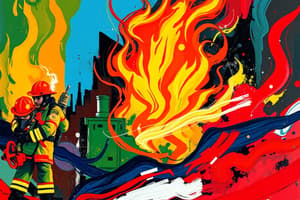Podcast
Questions and Answers
What is a characteristic of a broken stream in firefighting?
What is a characteristic of a broken stream in firefighting?
- Is similar to a solid stream in appearance
- Composed of coarsely divided drops (correct)
- Consists of water droplets in a very tight pattern
- Composed of a patterned formation of water
Which of the following is an advantage of using fog streams?
Which of the following is an advantage of using fog streams?
- Greater reach and penetration power than solid streams
- More effective in high wind conditions
- Less susceptible to creating steam burns
- Can provide exposure protection (correct)
What is the effective reach of a fire stream NOT significantly affected by?
What is the effective reach of a fire stream NOT significantly affected by?
- Water velocity
- Temperature of the air (correct)
- Gravity
- Fire stream pattern
Small streams are classified as those discharging how many gallons per minute (GPM)?
Small streams are classified as those discharging how many gallons per minute (GPM)?
What is the maximum outlet pressure to ensure proper operation of an in-line eductor?
What is the maximum outlet pressure to ensure proper operation of an in-line eductor?
What must be done with the foam eductor after each use?
What must be done with the foam eductor after each use?
Which type of fire stream is classified as discharging 350 GPM or more?
Which type of fire stream is classified as discharging 350 GPM or more?
What can occur if fog streams are improperly used during interior attacks?
What can occur if fog streams are improperly used during interior attacks?
A ______ stream is described as having water droplets in a very narrow tight pattern.
A ______ stream is described as having water droplets in a very narrow tight pattern.
One of the disadvantages of ______ streams is that they do not have the reach and penetration power of solid streams.
One of the disadvantages of ______ streams is that they do not have the reach and penetration power of solid streams.
Foam equipment using an in-line eductor operates based on the ______ principle.
Foam equipment using an in-line eductor operates based on the ______ principle.
The effective reach of a fire stream is affected by factors such as gravity, water velocity, and ______.
The effective reach of a fire stream is affected by factors such as gravity, water velocity, and ______.
A ______ stream is classified as discharging 40 to 349 GPM.
A ______ stream is classified as discharging 40 to 349 GPM.
Foam solution concentration must be correct at the rated inlet pressure of ______ PSI.
Foam solution concentration must be correct at the rated inlet pressure of ______ PSI.
The foam concentrate inlet to the eductor should not be more than ______ feet above the liquid surface of the concentrate.
The foam concentrate inlet to the eductor should not be more than ______ feet above the liquid surface of the concentrate.
Smoothbore hand streams operate at a nozzle pressure of ______ psi.
Smoothbore hand streams operate at a nozzle pressure of ______ psi.
Flashcards
Broken Stream
Broken Stream
A fire stream that is broken into coarsely divided drops, often used for cooling and suppressing flames.
Fog Stream
Fog Stream
A patterned stream composed of water droplets, offering advantages like hydraulic ventilation and exposure protection.
Gravity
Gravity
The force that pulls water downward, impacting a fire stream's reach.
Water Velocity
Water Velocity
Signup and view all the flashcards
Fire Stream Pattern
Fire Stream Pattern
Signup and view all the flashcards
Water Droplet Friction with Air
Water Droplet Friction with Air
Signup and view all the flashcards
In-Line Eductor
In-Line Eductor
Signup and view all the flashcards
Nozzle Pressure
Nozzle Pressure
Signup and view all the flashcards
Study Notes
Fire Streams
- Straight Streams: Appear and behave like solid streams, with water droplets in a very narrow, tight pattern.
- Broken Streams: A fire stream broken into coarsely divided drops. Produced by rotary distributor nozzles.
- Fog Streams: A patterned stream composed of water droplets.
- Advantages: Hydraulic ventilation, exposure protection, use near energized electrical equipment (reduced electrocution risk), and vapor dissipation.
- Disadvantages: Less reach and penetration power than solid streams; more susceptible to wind currents; improper use during interior attacks can spread fire, create heat inversions, and cause steam burns to firefighters.
Fire Stream Reach
- Affected by gravity, water velocity, stream pattern, water droplet friction with air, and wind.
Fire Stream Classification (by GPM)
- Small Streams: Discharge 39 gallons per minute (GPM) or less.
- Hand Streams: Discharge 40 to 349 GPM.
- Master Streams: Discharge 350 GPM or more.
Fire Stream Classification (by Pressure)
- Smoothbore Hand Streams: 50 psi nozzle pressure.
- Low-Pressure Fog Hand Streams: 50 psi nozzle pressure.
Hose Considerations
- Freezing: Subject to freezing but can be thawed and used.
- Pre-mixing: Can be premixed in the apparatus booster tank.
Foam Equipment (In-Line Eductors)
- Operation: Operates from a venturi principle; attaches to the pump panel or directly in the hose lay.
- Least Expensive: Least expensive foam production method.
- Operating Considerations:
- Eductor must control water flow through the system; outlet pressure must not exceed 70% of inlet pressure.
- Back pressure determined by nozzle pressure, friction loss between the nozzle and the eductor, and pressure created by elevation.
- Correct foam solution concentration only at the rated inlet pressure of 200 PSI.
- Eductors must be properly flushed and maintained after each use.
- Set the metering valve to match the concentrate percentage and the type of fuel.
- Concentrate inlet should not be more than 6 feet above the liquid surface of the concentrate.
- Troubleshooting (Eductor Failure):
- Partially closed nozzle
- Bypass valve open
- Improperly cleaned equipment, clogged with foam
- Hose lay too long
- Metering valve improperly set
- Nozzle elevated too far above the eductor
- Kinks in hose line
Studying That Suits You
Use AI to generate personalized quizzes and flashcards to suit your learning preferences.




